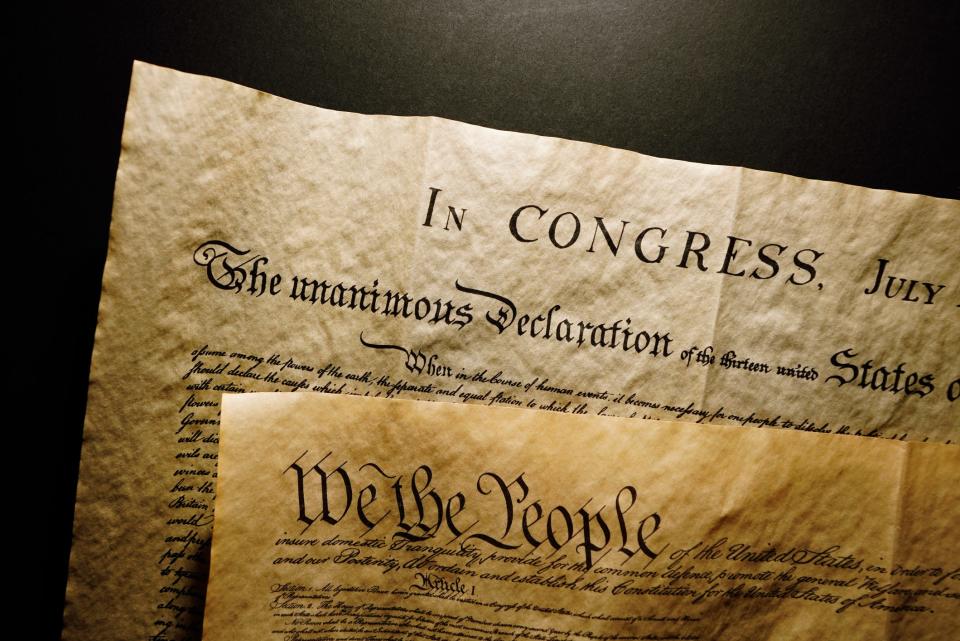What is the 25th Amendment? A simplified explanation of what it does, who can invoke it
- Oops!Something went wrong.Please try again later.
The 25th Amendment is once again a topic of discussion following a Justice Department report released Thursday concerning President Joe Biden's alleged mishandling of confidential documents and behavior in office.
The special counsel investigation, led by Trump appointee Robert Hur, determined that the evidence doesn't establish Biden's guilt beyond a reasonable doubt of mishandling classified documents in a criminal manner and found that charges were "unwarranted based on our consideration of the aggravating and mitigating factors."
However, the report also attributed part of this conclusion to Biden's "poor memory," painting a picture of an older man with memory issues and "diminished capacities." This has prompted a discussion of the 25th Amendment amongst the Republican party, as reps including House Speaker Mike Johnson, Marjorie Taylor Greene, R-Ga., and Sen. Rick Scott, R-Fla., have called for Biden's removal under the fourth section of the amendment.
The 25th Amendment was discussed similarly during Trump's presidency. However, Section 4 has yet to be successfully invoked and executed in U.S. history.

Here's what to know about the 25th Amendment and what invoking it can do.
What is the 25th Amendment?
The 25th Amendment addresses what happens if the president or vice president of the United States dies, resigns, becomes incapacitated or is otherwise unable to fulfill their duties. It was passed by Congress on July 6, 1965, and was ratified by the states on Feb. 10, 1967.
It also formalized the practice of the vice president taking over presidential office if the president dies or resigns and gives the president and Congress power to replace a vice president.
It was inspired by the assassination death of President John F. Kennedy, as confusion as to whether Vice President Lyndon B. Johnson had also been shot at the time led to questions about office succession.
Who can invoke the 25th Amendment?
Exonerated but not unscathed: Biden faces political nightmare with special counsel investigation

The 25th Amendment cannot be executed by a single party. Instead, it takes a few steps of approval by multiple parties.
The vice president is the primary starting point for invoking the 25th Amendment, specifically the fourth section. The vice president, in conjunction with either a majority of the executive Cabinet or a specific "body" designated by Congress, must invoke the Amendment in tandem.
The vice president takes over once these parties submit a formal written declaration to Congress. If the president refutes this, they can return to power for four days, in which time the other parties can again submit a declaration invoking the president's removal. If this happens, the VP takes over again and Congress must secure a two-thirds vote in both the House and Senate within 21 days to permanently remove the president.
How does the 25th Amendment work?
The 25th Amendment has four sections that can apply to different situations resulting in a president or vice president vacating or being forced to leave their position. In the case of presidential removal due to incompetence, it is Section 4 of the amendment specifically that applies.
Section 4 declares that, if the vice president and a majority of the executive Cabinet or a Congressionally appointed review body feel the president is no longer able to perform their duties, they can submit this belief in writing to Congress, resulting in the replacement of the president with the vice president. The president can submit a declaration to the contrary and bring the matter to voting in Congress.
Section 4 is the most controversial and has yet to be successfully used. The closest this section ever came to actual use was during Reagan's presidency, when he was undergoing surgery after being shot in March 1981. His administration prepared the paperwork to make Vice President George H.W. Bush acting president, but it was never signed. Several members of his staff again suggested it in 1987, arguing the president was mentally inept, but his chief of staff disagreed and it was not further pursued.
It was again proposed during Trump's presidency but was not ultimately invoked.
25th Amendment text
Section 1
In case of the removal of the President from office or of his death or resignation, the Vice President shall become President.
Section 2
Whenever there is a vacancy in the office of the Vice President, the President shall nominate a Vice President who shall take office upon confirmation by a majority vote of both Houses of Congress.
Section 3
Whenever the President transmits to the President pro tempore of the Senate and the Speaker of the House of Representatives his written declaration that he is unable to discharge the powers and duties of his office, and until he transmits to them a written declaration to the contrary, such powers and duties shall be discharged by the Vice President as Acting President.
Section 4
Whenever the Vice President and a majority of either the principal officers of the executive departments or of such other body as Congress may by law provide, transmit to the President pro tempore of the Senate and the Speaker of the House of Representatives their written declaration that the President is unable to discharge the powers and duties of his office, the Vice President shall immediately assume the powers and duties of the office as Acting President.
Thereafter, when the President transmits to the President pro tempore of the Senate and the Speaker of the House of Representatives his written declaration that no inability exists, he shall resume the powers and duties of his office unless the Vice President and a majority of either the principal officers of the executive department or of such other body as Congress may by law provide, transmit within four days to the President pro tempore of the Senate and the Speaker of the House of Representatives their written declaration that the President is unable to discharge the powers and duties of his office. Thereupon Congress shall decide the issue, assembling within forty-eight hours for that purpose if not in session. If the Congress, within twenty-one days after receipt of the latter written declaration, or, if Congress is not in session, within twenty-one days after Congress is required to assemble, determines by two-thirds vote of both Houses that the President is unable to discharge the powers and duties of his office, the Vice President shall continue to discharge the same as Acting President; otherwise, the President shall resume the powers and duties of his office.
This article originally appeared on USA TODAY: What is the 25th Amendment? Who can invoke it and how is it used?

